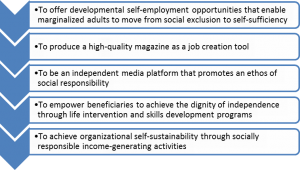Street Papers
Introduction – What are Street Papers?
Street papers are newspapers or magazines that are published to be sold by homeless, unemployed, and/or socially marginalized individuals giving them employment opportunities that allow them to take charge of their own lives and advance their careers. The street paper model is self-help driven; vendors essentially become their own bosses by being micro-entrepreneurs who are responsible for their own successes. In this model, vendors buy the newspapers or magazines from their local street paper at half the cover price then sell the paper on the street at full price keeping anything they make. Street papers programs are popular among both developing and developed countries alike. The publications cover mainly topics surrounding homelessness and poverty in the local street papers respective area. Some street papers even allow vendors to become writers to share their thoughts about issues in their communities.
The Modern Street Paper: Giving the Unemployed a Hand Up, Not a Handout
The street paper movement began in the late 1980’s when homeless and unemployed individuals started writing and selling newspapers for a profit. The movement began in some major cities in the United States. The newspaper frequently cited as the first modern street paper was established in 1989 in New York City and was called Street News. Street News published a magazine focused on poverty-related issues and allowed homeless adult vendors to sell the magazine to give them employment opportunities. Because of its success, Street News’ methodology became the model for many street papers that exist today.
Many street papers began popping up all over the world in the mid-to-late 1990’s. One of these included the world’s most popular and well-known street paper, The Big Issue. John Bird and Gordon Roddick founded The Big Issue in 1991 in the United Kingdom in response to the increasing number of homeless people in London. Following the success of The Big Issue in the United Kingdom, the late 1990’s and early 2000’s saw the expansion of The Big Issue to countries around the world (Harman, 2003). The Big Issue can currently found in nine countries including the United Kingdom, Australia, Japan, South Africa, South Korea, Namibia, Kenya, Taiwan, and Malawi.
The Big Issue is a part of an organization called The International Network of Street Papers (INSP). The INSP was founded in 1994 and supports over 120 street papers. These street papers are based in about 40 different countries. The INSP website outlines the purpose of street papers. “Street papers are independent newspapers and magazines that operate on a social enterprise and self-help model to provide an innovative solution to urban homelessness and unemployment.” According to INSP, in order to make this model work the people who sell the papers, or vendors, buy the paper from the publisher at half the cover price. They sell it at cover price, so they get 50% of the profits. The profit that the publishers get goes to the publishing of the paper and various other programs the paper organization may offer. The publishers are often non-governmental organizations (NGOs) and are almost always not-for profit (http://www.street-papers.org).
Although there has been success with street papers, they have also received some criticism. Some charities and smaller street papers argue that the larger street papers, such as The Big Issue, aren’t doing enough for their vendors. Many of the larger street paper organizations hire professional writers to write about pop-culture and big events in the world as opposed to homeless and unemployment issues in hopes that these topics will generate a wider audience, gaining larger sales for vendors and the organization. This has led many individuals, charities, and smaller street papers to argue that the larger papers aren’t spreading the right information or offering appropriate services for the vendors. Messman (1998) argues that this opposition from smaller street papers is an attempt to prevent the expansion of larger papers to their area.
Narrowing in: A Brief History of Our Sponsor
The Big Issue South Africa was first was launched in 1997 in response to bullying, illegal treatment of homeless and other vulnerable people on the streets of Cape Town by authorities, including police, traffic authorities, and private security companies. It is modeled after The Big Issue London, founded by John Bird. The dream of the Big Issue South Africa came to life thanks to a small group of people, including Debi Diamond who was well-known to in the homeless community because she ran a soup kitchen from her home in Wynberg.
When The Big Issue South Africa first started, editions came out every 3 months discussing topics of pop-culture and world events written by professional journalists. Today, the issues still cover similar topics, but are released every 3 weeks (21 days). The current total vendor force is roughly 300 individuals, although only about 150 vendors are considered active. A variety of workshops are provided to these vendors to help advance their career and life skills. Topics of these workshops often include strengthening entrepreneurial skills and parenting.
In a special edition of one of the paper, Issue 215 Volume 1, each editor described their view of The Big Issue. The editor from 2007 to 2009, Donald Paul, summarized the essence of the initial mission of The Big Issue: “The Big Issue wanted to help to create awareness of how individuals can contribute to civil society and make a difference, even in a small way, at an urban level – such as buying a copy of a magazine. More of a challenge was to shift that buy from being a ‘grudge’ purchase – done simply to move the vendor away from car window – to a mindset that each one of us can contribute to change.”
The Big Issue’s Vision Statement, provided in every issue of the The Big Issue magazine, is as follows:
The Big Issue is a socially responsible organization that enables willing, unemployed and marginalized adults living in South Africa to take responsibility for their own lives through a developmental educational programme.
The set of the The Big Issue’s Mission Objectives printed in every magazine are outlined in the graphic below.
The Big Issue South Africa recently won the 2013 INSP award for an Outstanding Contribution to the International Street Paper Movement. The reasons for this were outlined by the INSP judges saying, “The Big Issue South Africa leads the way for sustainable street paper development on the continent, supports colleagues in other African countries and also supports the development of INSP as an organization” (http://www.street-papers.org/). They have been also recognized for their recruitment, retention, and support of their women vendors.
The link to the Big Issue South Africa’s website can be found here.
Continue to Interviewing




